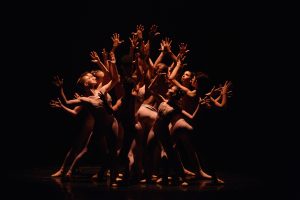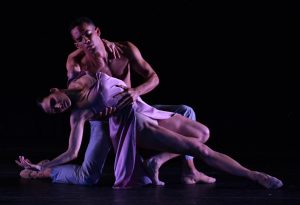
The Duncan Theatre opened its popular Modern Dance Series on Jan. 20 with a new addition that deserves to be remembered — Dimensions Dance Theatre of Miami.
Founded six years ago by husband-and-wife Artistic Directors Carlos Guerra and Jennifer Kronenberg, this young company has a high dose of energy mixed with a tangible down-to-earth quality. In the post-performance talk-back, the two former principal dancers with Miami City Ballet said said that after retiring from performing, they found themselves searching for a way to give back to the community that had supported them for so many years.
After discovering a group of strong dancers in Miami, they decided to start a dance company that would generate opportunities for them, and since then, they haven’t looked back.
The four works presented over the weekend allowed the audience to get a good sense of the company’s persona. The first and last dances on the program were fast-paced, large-group works that were designed to satisfy the audience as well as the performers. Both ensemble pieces succeeded in doing just that — one pulled us in and the other sent us off in high spirits.
The aspiring company had a good opener with Light Rain, the most sought-after work from Joffrey Ballet’s co-founder and choreographer Gerald Arpino. Choreographed in 1981 and capturing the spirit of the New Age era, Light Rain is among a group of Arpino works known as the California ballets.

Set to the enticing drum rhythms of Douglas Adamz and Russ Gauttier’s fusion of East-meets-West melodies and percussion, it featured 14 dancers dressed in flesh-toned unitards and tights who criss-crossed the stage with “feeling good” movement in the opening and closing ensemble sections. But the sensual duet, placed in the middle of the dance, is the section that has always stood out in the many company performances I have seen over the years.
The choreography from this duet still managed to enthrall and even to feel new. Illuminated by a warm cone of of downward light, Daniel White, tall and elegant, manipulated the malleable Chloe Freytag by effortless bending, lifting and stretching her while on pointe in a manner that 40 years ago was viewed as scandalously erotic for ballet. Friday night’s performance by Freytag and White, though technically competent, came across as somewhat tame. Their interaction lacked real connection and would have benefited from some more smoldering. It was all smooth edges with little hint of sexual tension or connection to the simmering sensual drumbeat.
When Armando Brydson came out in the last section and danced a quick solo, the music really came alive onstage. Totally connected to the sound, with his wild hair bouncing, he released an unbridled energy that seemed to capture the spirit of the time and embody the soul of the music.

The artistic apex of the evening was the exquisitely performed duet in Landscapes danced by Melissa Verdecia and Lyvan Verdecia, whose rich interpretation of the choreography was filled with beautiful and nuanced movement qualities. The couple (who are married in real life) sensitively captured the changing dynamics of an intimate relationship between a woman and a man. There was an immediacy to their performance as if it were the first time they had experienced these feelings and emotions as they let the mastery of their technique serve their artistry in a most authentic and mesmerizing way.
This duet was the last in a series of three love duets created by local choreographer Donna Goffredo Murray, who was inspired by a series of poems written by Lani Scozzari and the music of The Chopin Project, a recording by the German pianist Alice Sara Ott and the Icelandic producer Olafur Arnalds. The first love duet, which was for two women, was fluid and gestural and danced with some reserve by Selah Jane Oliver and Paulina Zambrana. The second duet for two men was danced with more conviction by Yanis Eric Pikieris and Daniel White. The connected and kinetic partnering between the tall White and smaller Pikeris was seamless and musical.
There was another duet also on the program, Sobre un Hilo (translated as On Top of a Thread), choreographed by company dancer Lyvan Verdecia to the electronic dance music of the English duo Badmarsh & Shri. In almost darkness, Miranda Montes de Oca and Brian Gómez performed an action/reaction duet that was filled with pulling and pushing that (according to the notes in the program) represented a time in the choreographer’s past life in Cuba that was filled with turmoil and anxiety. Curiously, the two performers, who were technically strong, were mono-dynamic and expressionless in their athletic partnering, which left me wondering if this was part of the choreographic intent.
Closing the program was Adiemus, choreographed in the late 1990s by Yanis Pikeris (father of company dancer Yanis Eric Pikeris) and David Palmer for the now defunct Miami-based Maximum Dance Company. The exuberant ensemble work is fueled by the music of Welsh composer Karl Jenkins. Originally devised in 1994 as a TV advertisement for Delta Airlines, Jenkins later developed Adiemus into a full choral work. The driving, world-music score made one feel that you were part of some kind of tribal rite.
Jenkins said that the choral lyrics were written in “an invented language” that mimicked a musical instrument. Since there are no words to distract, Jenkins felt that the listener could better focus on the soaring phrasing of the free-flowing vocals. Consequently, this score was an exhilarating end to the evening’s performance together with the free-flowing movement the choreographers utilized.
A breather from the pace of the work came with the youthful air of the duo, Meisy Laffitte and Alexey Minkin, who performed a well-executed but somewhat bland duet on the brightly lit stage.
In the last segment of Adiemus, the ensemble dancers returned presenting a mixed medley of energy and styles but, at times, struggling to keep up with the whirlwind choreography. It was the quick-footed Paulina Zambrana, dressed in pale gray, who caught my eye as she wove in and out of the exuberant patterns of movement as if she could dance as fast and pristinely as she was all day long. Her grace and calm was as welcome as a breeze of cool air on a heated summer day.
Dimensions Dance Theatre of Miami — which recently added another former Miami City Ballet principal dancer to its pool of talent, the exceptional performer Emily Bromberg — has been collecting some well-deserved acclaim in its six short years (three of which have been during the COVID-19 pandemic). Having survived as a performing arts organization during this distressed time is alone an enormous feat but carving out a much-needed artistic home for local dancers is a truly praiseworthy accomplishment.